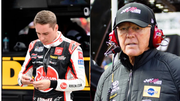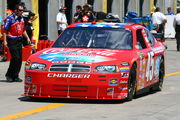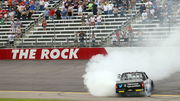
via Imago
NASHVILLE, TN – JUNE 24: Ryan Preece 41 Stewart Haas Racing Morton Buildings Ford looks on during qualifying for the NASCAR, Motorsport, USA Cup Series Ally 400 on June 24, 2023, at Nashville Superspeedway in Lebanon, TN. Photo by Jeffrey Vest/Icon Sportswire AUTO: JUN 24 NASCAR Cup Series Ally 400 EDITORIAL USE ONLY Icon230624458

via Imago
NASHVILLE, TN – JUNE 24: Ryan Preece 41 Stewart Haas Racing Morton Buildings Ford looks on during qualifying for the NASCAR, Motorsport, USA Cup Series Ally 400 on June 24, 2023, at Nashville Superspeedway in Lebanon, TN. Photo by Jeffrey Vest/Icon Sportswire AUTO: JUN 24 NASCAR Cup Series Ally 400 EDITORIAL USE ONLY Icon230624458
In a heart-stopping turn of events at the Daytona International Speedway, NASCAR driver Ryan Preece was entangled in a high-speed dance of chaos and survival. The world held its breath as Preece’s car somersaulted across the asphalt, the unmistakable echo of twisting metal and roaring engines filling the air. In seconds, a race transformed into a daring escapade for life, leaving everyone wondering if he would emerge unscathed.
Against all odds, the aftermath painted a portrait of resilience. Preece, the 32-year-old daredevil of speed, emerged from the wreckage with helping hands. As the dust settled, his battered #41 Ford stood as a testament to the sheer force of the impact. But Preece’s spirit refused to bow to adversity. With unwavering determination, he was whisked away to medical care, his journey into uncertainty beginning.
ADVERTISEMENT
Article continues below this ad
Survival Beyond Speed: Ryan Preece’s Miraculous Escape
Preece’s miraculous escape, a feat that seemed to defy the laws of physics, was not a mere twist of fate. It was the convergence of innovation and design – a nod to the relentless pursuit of safety in the world of the NASCAR Cup series. The Next-Gen car, a marvel of engineering born from trial and error, demonstrated its true mettle. It shielded Preece during those harrowing rolls, transforming the devastating crash into a dramatic reminder of how far technology has come to protect those who dare to chase the edge of speed.
Ryan Preece soon took to his social media to post a message for his fans, “If you want to be a race car driver, you better be tough.
Dammit. Fast @racechoice @FordPerformance Mustang. I’m coming back.”
If you want to be a race car driver, you better be tough.
Dammit. Fast @racechoice @FordPerformance Mustang. I’m coming back.
— Ryan Preece (@RyanPreece_) August 27, 2023
In recent years, NASCAR, often a theater of adrenaline and speed, has had its share of reckoning. The debut of the Next Gen car in 2022 brought a chorus of criticism as drivers grappled with the consequences of collisions. Yet, a transformation occurred as the dust settled and the engineers fine-tuned their creations. The menace of G-forces and the looming specter of concussions began to wane, and the racing world breathed a sigh of relief as missed races and traumas dwindled.
WATCH THIS STORY: Chase Elliott’s Aggressive Mindset Hours Before the Highly Speculated Run Warns the Whole NASCAR Grid
Fans and enthusiasts, like modern-day detectives, have delved deep into the crash’s details, unveiling a potentially life-threatening flaw in the much-touted NextGen car.
Trending
Internet Detectives at Work: Fans Analyze Spin Angles and Design Elements in Search of Answers For Ryan Preece
Questions swirl around the Stewart-Haas Racing driver’s crash as the dust settles, sparking a wave of speculative curiosity that refuses to be tamed. The unsettling observation revolves around the precise spin angle at which the NextGen cars seem to lift off during crashes. Whispers of intrigue have woven their way through online forums, where armchair analysts share their theories like puzzle pieces waiting to be fit for Ryan Preece.
In all the NextGen airborne crashes, the car lifts from almost the exact same spin angle:
“And all three cars were Fords. Not saying it matters, just interesting.” one fan mused.
Another wrote, “Also all on superspeedways, where all fords are fast. Not saying there’s something there but odd.”
“Also, Ford is based out of Detroit, and as they say, “can’t have shit in Detroit.” Looking into it!” someone chimed in.
One Reddit user commented, “The Next Gen has two things that are different than the last however many years of plate racing: Higher ride height and a smooth floor
Both of those are going to allow air to flow easier under the car and create liftoff.”
“I said this on another post a good while ago. Roof flaps that are directly angled to each side. Could maybe help, but the floor probably is the issue,” a NASCAR fan stated.
“It’s almost like they have a flat surface underneath that acts like an airplane wing; delete the diffuser and delete the skid plate!” another added.
A fan went into length to explain, “Now I’m down the rabbit hole on this one and found something kind of fascinating: Briscoe got air but then immediately settled back down. What was different? Both roof flaps fully engaged as the car went backward.
With both Harrison and Preece, only the left flap opened significantly. Seems like something that might be worth looking into because Briscoe really should’ve had a Preece-like tumble if all things were equal.”
“Most blowovers are because the car goes sideways. Doesn’t matter if it was nextgen or prior. When cars are running at speeds faster than airplanes take off, this is what happens.” one NASCAR enthusiast wrote.
ADVERTISEMENT
Article continues below this ad
In all the NextGen airborne crashes, the car lifts from almost the exact same spin angle.
by u/hoover757 in NASCAR
As the checkered flag waved over the track, leaving a trail of burnt rubber and echoing cheers, the narrative was far from over. From the apex of speed to the nadir of uncertainty and back again, Preece’s journey became a memorable chapter in the story of NASCAR.
ADVERTISEMENT
Article continues below this ad
With every twist and turn of the track, the future holds both anticipation and curiosity. What tales will the racing gods script next? What feats of bravery and engineering will arise?
ADVERTISEMENT
ADVERTISEMENT
ADVERTISEMENT
ADVERTISEMENT






